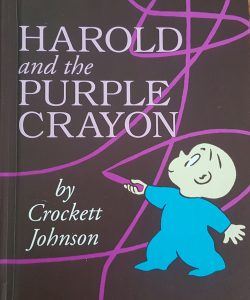

Title: Harold and the Purple Crayon
Author: Crockett Johnson
Illustrator: Crockett Johnson
Publishers and Year: Harper Collins Publishers, 1955
Number of pages: 63
Genre: Fiction
Harold and the Purple Crayon takes the reader on an adventure through the imagination of a young boy name Harold. Throughout the story, the reader witnesses Harold create an imaginary world full of adventure and peril with a single purple crayon. The story ends with Harold drawing his own bedroom around himself and falling asleep.
The story of Harold and his crayon acts as both a mirror and a door for its audience. It functions as a mirror in that it allows its audience to reflect on their own imaginative and creative tendencies. Every human has creative tendencies to one degree or another. The story of Harold fashioning an entire new world with a simple crayon has the power to awaken that within its readers. In addition to this, all people have a natural need for stability in their lives. As Harold searches for his home, the readers are able to connect with that desire and need, even if on a subconscious level. Not only does Harold’s tale function as a mirror, but it also functions as a door in that it activates and empowers its readers to boldly create and not be afraid to leave their mark on the world.
The illustrations in the book are spread across the entire page and unframed throughout the book. This invites the reader into the adventure Harold is having so that the reader might experience it alongside Harold. Also, the illustrations help to reinforce Harold as a character, as well. For example, the background is all 2-Dimensional while Harold himself is 3-Dimensional. This shows us that, despite living in a 2-Dimensional world, Harold is open-minded and less superficial. This just emphasizes Harold’s role as a creative being compared to the world around him. This is not the only way in which the illustration was intentional. One of the most consistent things about the illustrations is the purple horizon line that Harold draws as he drags his crayon across the page. However, the horizon line disappears multiple times throughout the book to alert the reader to upcoming danger.
The images in this story are a powerful addition to the text. The images show him boldly creating a world from scratch while the text depicts the adventure happening to him, as if it were something he simply stumbled upon. For example, the author uses phrases like “it turned out to be an apple tree.” This contrast shows the intentional split between being bold in our imagination and the surprise that can come when we allow ourselves to walk in such boldness and freedom of thought. Overall, this Harold’s journey offers its readers an opportunity to push the limits of their own creativity without fear of failure.
